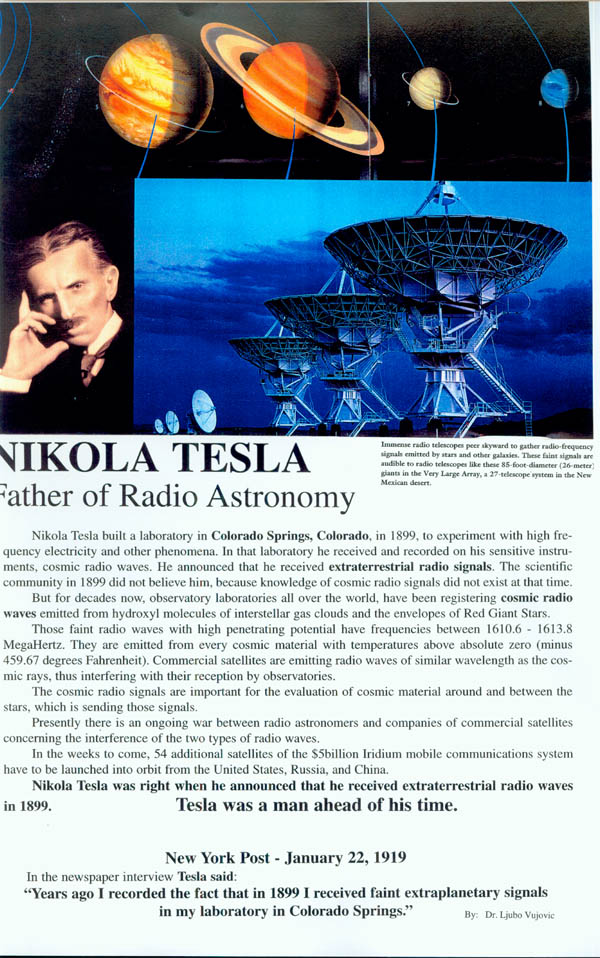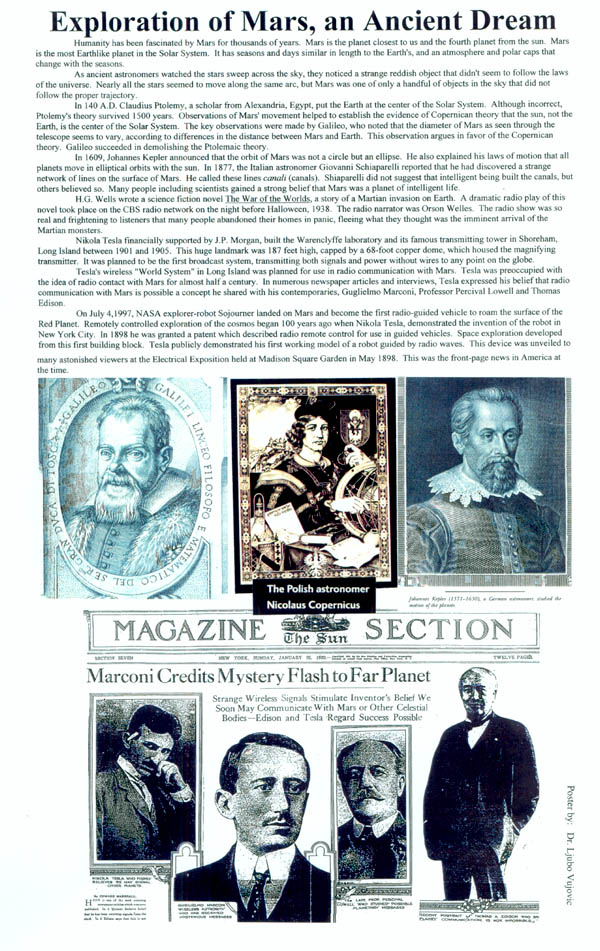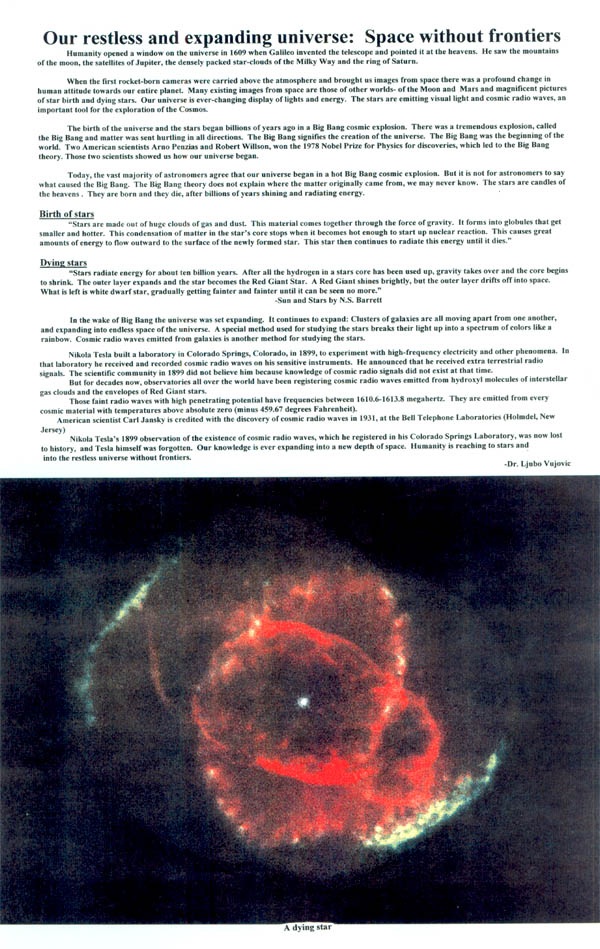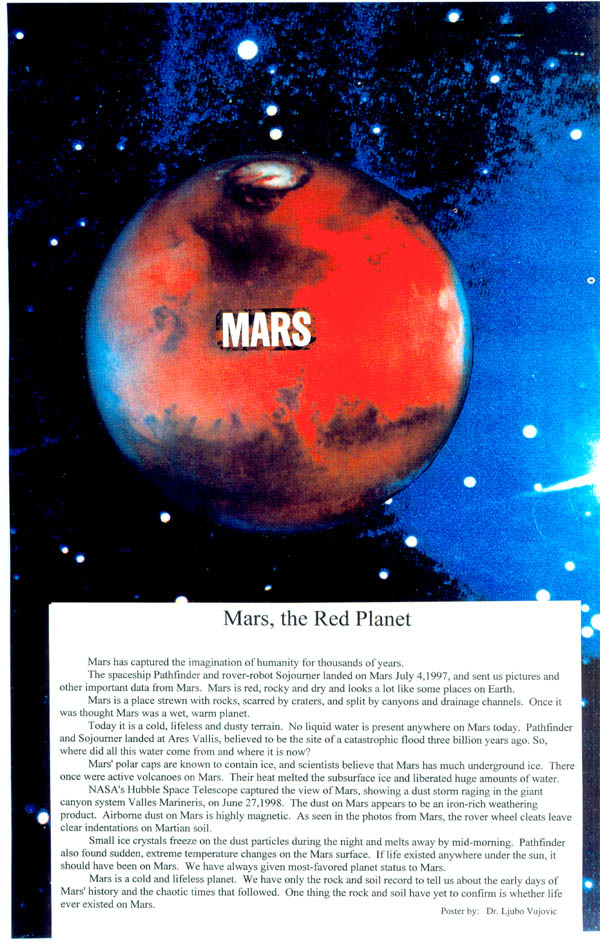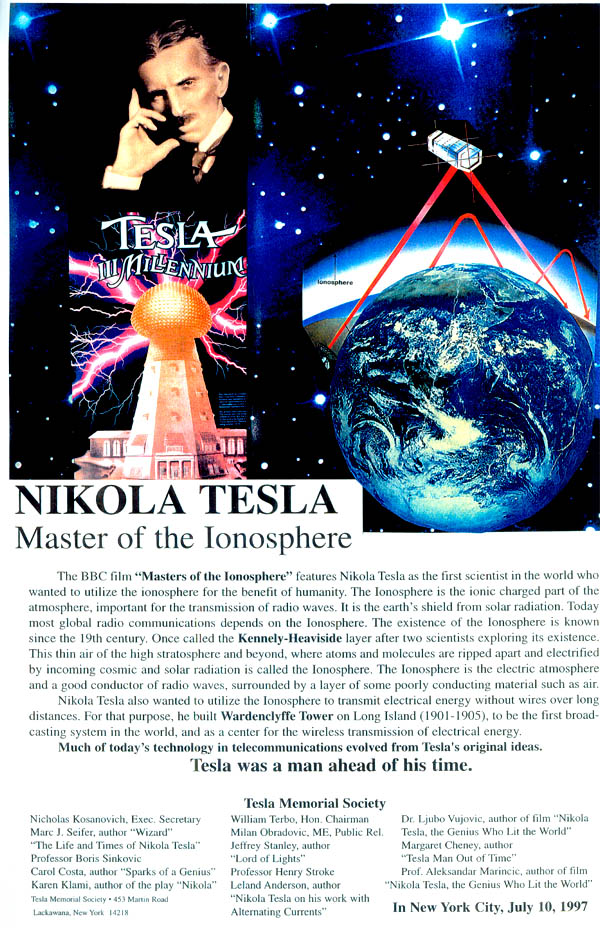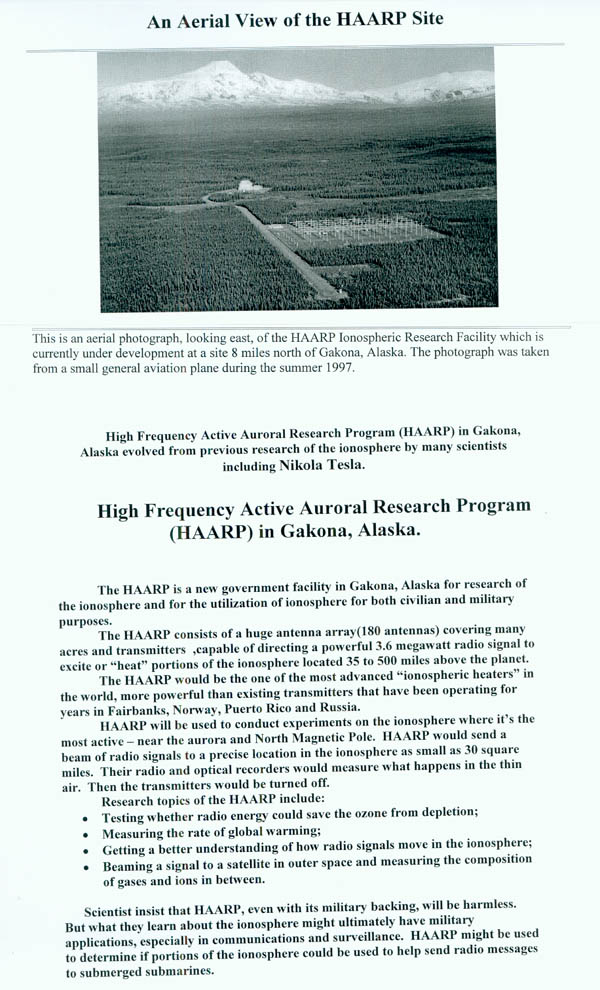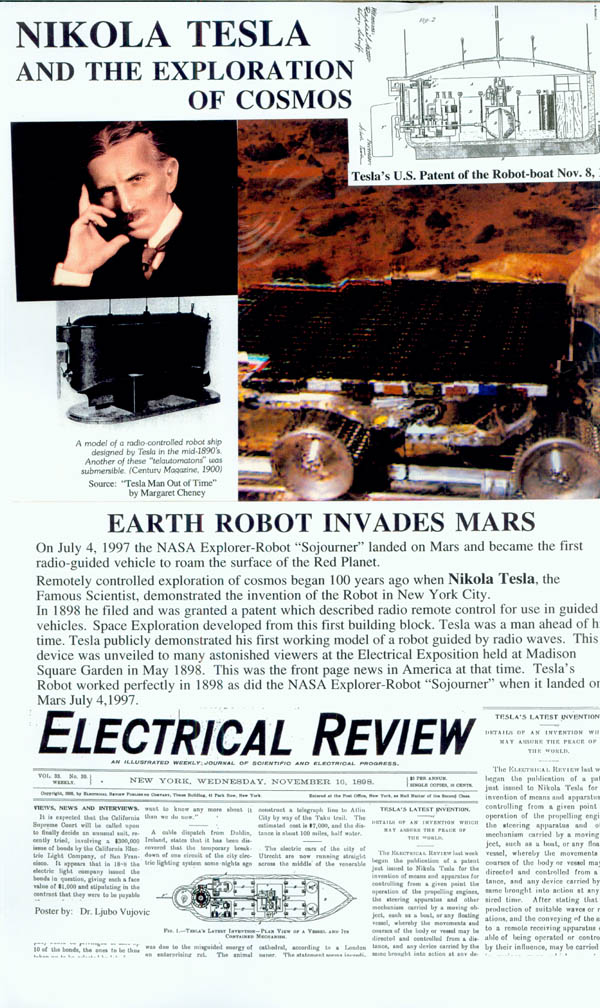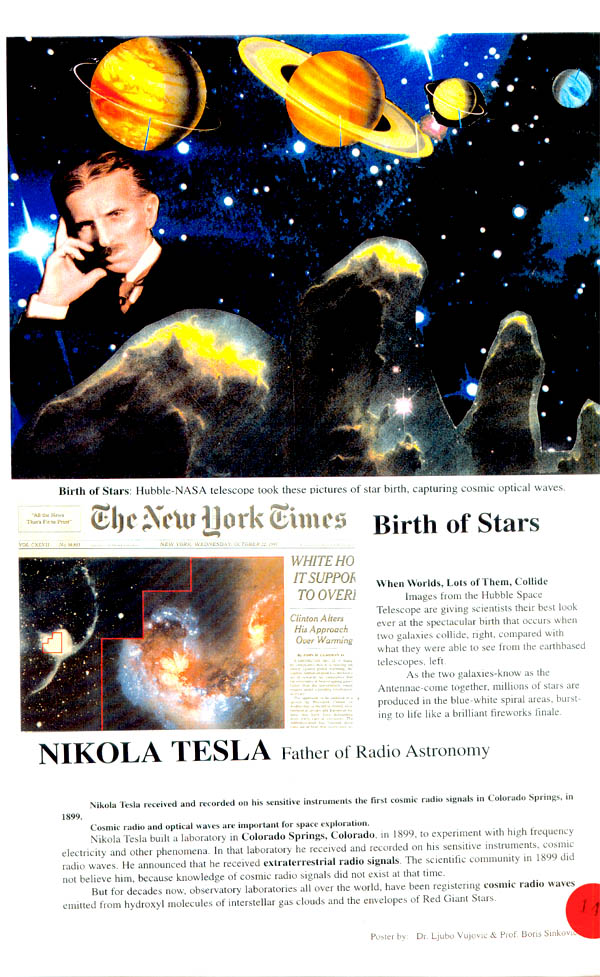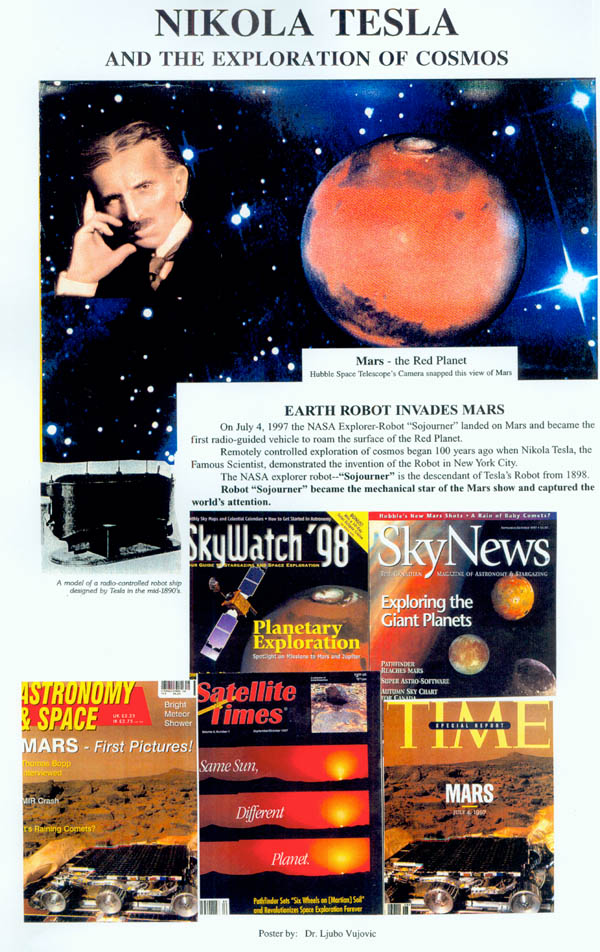
Welcome to the Tesla Memorial Society of New York Website
“To Mars with
Tesla; or, the Mystery of Hidden Worlds”, a Science Fiction Tale from
1901,
Tesla and the Exploration of Cosmos
Nikola Tesla spent 50 years of his life trying to find a way to communicate with Mars. Tesla believed that Mars was inhabited with intelligent Martians and had a civilization, as evidence by the canals of the red planet -Mars, which could be seen by telescope. This belief about Martians was common at the time when Tesla was alive. This novel "To Mars with Tesla" illustrated Tesla's intention to communicate with Mars. This is science fiction.
Nikola Tesla contributed to the exploration of cosmos by discovering the first wireless robot in 1898 which he demonstrated in Madison Square Garden. This was the first radio guided robot. Tesla discovered remote control, so important to send signals to satellites and spaceship around the globe, to guide their movement. Tesla discovered cosmic radio waves in his laboratory in Colorado Springs, 1899. Cosmic radio waves are important for the analysis of planetary matter and the composition of stars/planets, which emit those cosmic waves. Today there are numerous installations in the world made by the United States, Russia, Japan, etc. which are analyzing cosmic radio waves.
Tesla is one of the first scientists in the world who used the ionosphere for scientific purposes (see BBC film: "Masters of the Ionosphere"). The ionosphere is used for radio communications around the globe. The HAARP project is based on Tesla's principles. When Tesla built the Wardenclyffe Tower in Shoreham, Long Island, he included the "Tesla Tower" function for communication with Mars.
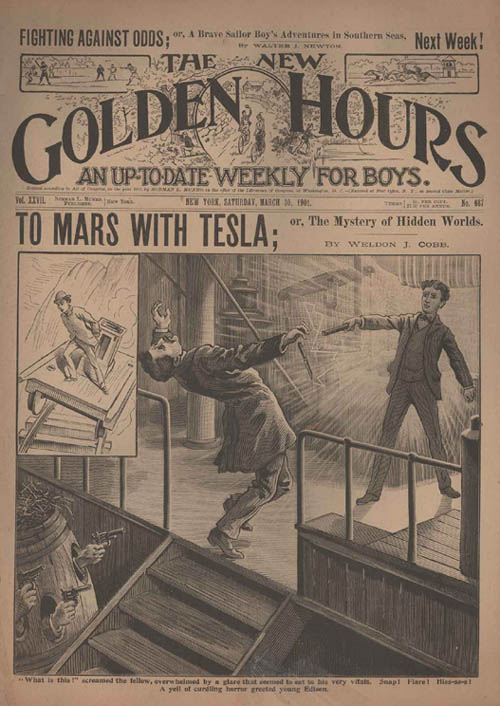
Above: “To Mars with Tesla; or, the Mystery of Hidden Worlds”, 1901.
The Tesla Memorial Society of New York is grateful to Mr. Dennis Gannon, Washington D.C. for his kind information about this science fiction tale, “To Mars with Tesla; or, the Mystery of Hidden Worlds”.
The following summary about “To Mars with Tesla; or, the Mystery of Hidden Worlds” is used from Fantastic Victoriana, which can be found at: http://www.geocities.com/jessnevins/vice.html?200624
The Magazine "New Golden Hours" (from New York) printed this sci-fi
tale from
March 30 to May 18, 1901. Written by J. Weldon Cobbs (1866 - 1902).
Edison, Young. Young Edison was introduced in J. Weldon Cobb's To Mars With Tesla; or, the Mystery of Hidden Worlds, which appeared in New Golden Hours from March 30 to May 18, 1901. Cobb (1866-1902) was a Chicagoan who wrote both journalism and dime novels; he contributed to the Tousey books as well as acting as publisher himself. Young Edison probably shouldn't be the subject of his own entry, as he's not so much an inventor as the teenaged focus of To Mars With Tesla, but it didn't feel quite right to lead with Tesla. To Mars With Tesla has a number of subplots in it and is chock full o'action, and so I'll just touch on the highlights. Nikola Tesla--the Nikola Tesla, and not someone like Tesla (ala "Thomas Edison" in Eve of the Future)--is interested in communicating with Mars; he is quite certain that Mars is inhabited, as evidenced by the canals on the planet. Tesla is putting together a light-projecting device similar to a laser with which he hopes to send a signal to Mars; he's also putting together a light-detector which will work something like radar to tell whether the signal gets there. In this Tesla is aided by Young Edison, his college boy nephew. (Why Tesla, who had a great and bitter rivalry with Edison, would put up with a cousin named after his hated rival, is beyond me, but never mind) Tesla is also assisted by Professors Combe and Weir.
Unfortunately, Tesla is opposed in his plans by a few figures. There's Heinrickson, a generally bad fellow, a murderer, thug and bounder. There's Zadir and Hazir, two criminals of non-American ancestry who've somehow come by advanced flying machines and are zooming across the skies of America pretending to be Martians. And, finally, there's Herschel de Vega, a mad scientist who is building a spaceship (inside his laboratory, which is inside a hollow mountain) to get to Mars. Most of the novel involves various individuals, especially Edison, getting kidnaped by each other. At one point Young Edison is captured by Heinrickson and fired into the air by a giant slingshot, but fortunately for everyone but the reader Young Edison lands on top of Tesla's private propeller-driven balloon. (Tesla's also got propeller-driven individual flying suits and "electric pistols") Eventually de Vega snares both Tesla and Young Edison and puts them in his spaceship, which has a rubber nose to reduce the shock of impact. They take off and then land in a desolate and strange desert, with de Vega swearing he's landed on Mars and Tesla disagreeing. Tesla's right, of course, as they're only in a gigantic meteorite crater in the American Southwest. Young Edison saves Tesla's life and gets him to safety, de Vega dying of a scorpion bite. Soon enough the signal is sent to Mars. The novel ends with Tesla and Young Edison waiting for a response. To Mars With Tesla is a novel best read in summary.
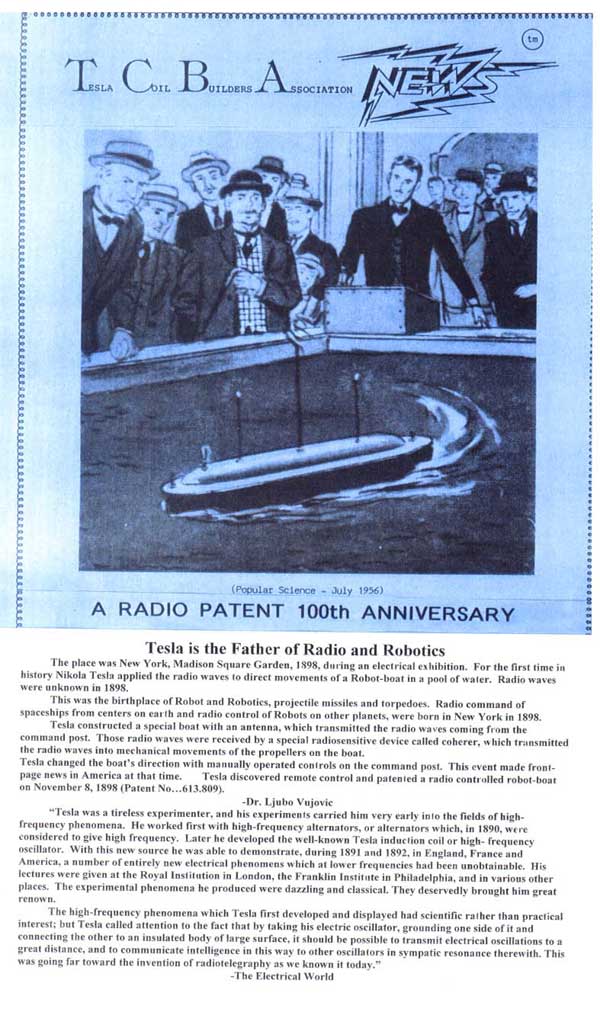
NIKOLA
TESLA
AND
THE EXPLORATION OF COSMOS

This is a collection of many of the best images from NASA's planetary exploration program. The collection has been extracted from the interactive program "Welcome to the Planets" which was distributed on the Planetary Data System Educational CD-ROM Version 1.5 in December 1995.
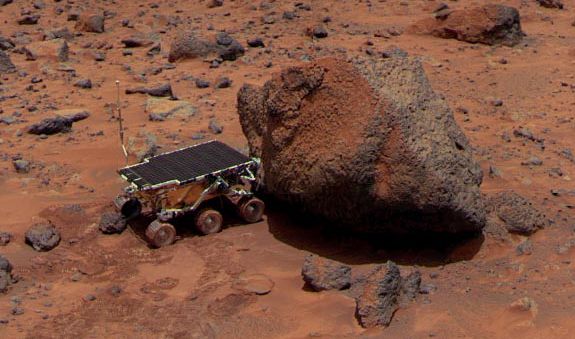
Remotely controlled exploration of the
cosmos began 100 years ago when Nikola Tesla
demonstrated the invention of the robot in New York City.
In 1898 he filed and was granted a patent which described radio
remote control for use in guided vehicles.
Space exploration developed from this first building block.
Tesla publicly demonstrated his first working model of a robot
guided by radio waves. This
device was unveiled to many astonished viewers at the Electrical
Exposition held at Madison Square Garden in May 1898.
This was front page news in America at that time.
It was the first time that the radio waves were used to guide a
movement of a robot-eleven years before Marconi was awarded the Nobel
Prize for the discovery of radio in 1909.
This historic moment at Madison Square Garden in New York City in
1898 showed what marvels could be achieved by using radio waves.
It was the beginning of robots and robotics, radio guided
missiles and remote control.
The radio communications and the
computer guided spaceships from mission control centers are based on
Tesla’s principal of radio remote control for use in guided vehicles.
Nikola Tesla built a laboratory in
Colorado Springs, Colorado, in 1899, to experiment with high frequency
electricity and other phenomena.
In that laboratory he received and recorded on his sensitive
instruments, cosmic radio waves. He announced that he received extraterrestrial radio signals.
The scientific community in 1899 did not believe him, because
knowledge of cosmic radio signals did not exist at that time.
Nikola Tesla and the Exploration of Cosmos Posters
